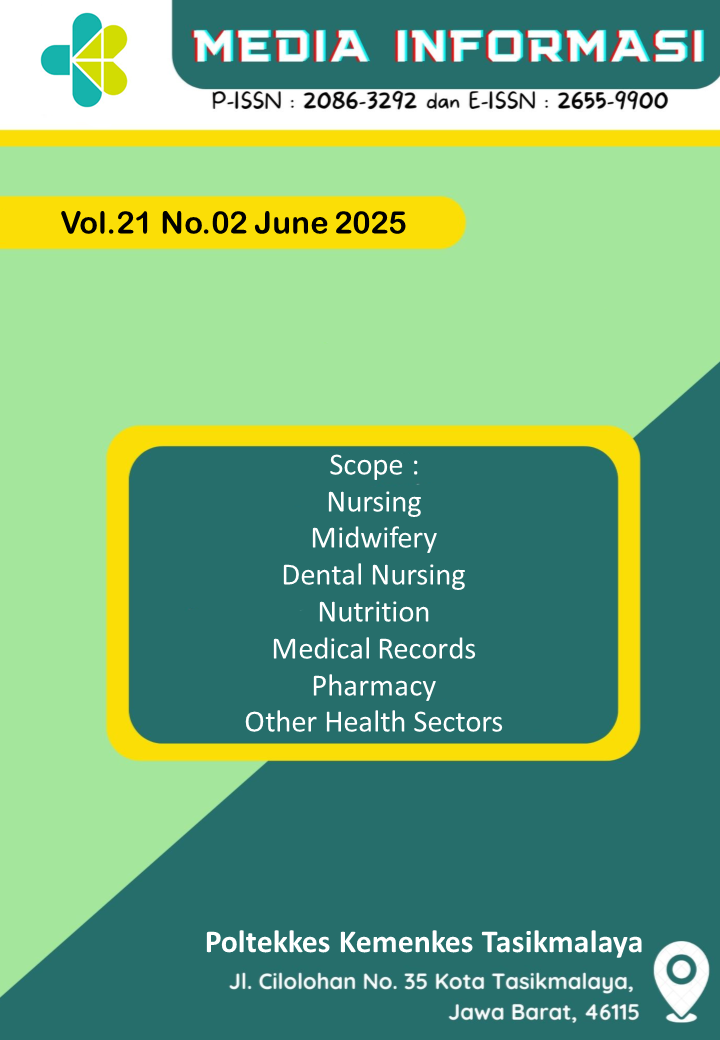FORMULATION OF PEPPERMINT ESSENTIAL OIL AROMATHERAPY PREPARATIONS: A PRELIMINARY STUDY ON THE ORGANOLEPTIC
DOI:
https://doi.org/10.37160/mijournal.v21i02.782Keywords:
Peppermint essential oil, aroma-therapy, organoleptics, formulationAbstract
Background: Peppermint oil has a distinctive refreshing aroma as well as analgesic, antispasmodic, and calming effects, making it suitable for use in aromatherapy. This study aims to develop formulations and evaluate the organoleptic properties of peppermint essential oil-based aromatherapy preparations, which are known to have therapeutic benefits in reducing stress, increasing alertness, and providing a relaxing effect. Method: The research method used a laboratory experimental approach with two formulations of different concentrations of peppermint essential oil, menthol, and olive oil. Organoleptic tests involved visual observation of shape, color, aroma, and sensation on the skin, along with pH measurements and preference tests on 40 respondents. Results: The results showed differences in organoleptic properties between the two formulations. The first formula was brown in color with a strong aroma, while the second formula was yellowish brown with a more fragrant and softer aroma, which was preferred by respondents. Both formulations gave a warm sensation on the skin, while pH measurements showed a range between 5 and 6, which is safe for the skin as per the pH standard of topical products (4.5-6.5). In the favorability test, the second formulation received higher preference from respondents, especially in terms of aroma and feel on the skin. Conclusion: this peppermint oil based aromatherapy formulation showed positive results in organoleptic aspects and pH safety, so it has the potential as a natural aromatherapy product that can be well received by consumers. This research opens up opportunities for further development regarding the stability and therapeutic potential of essential oil combinations in aromatherapy.
Downloads
References
Aulia, W. M. (2023). Creative Fusion: Dim Sum Variation for Vegetarians Using White Tofu With Carrots, Bamboo Sprouts, and Mushroom Substitute. Journal of Food and Culinary, 33–39. https://doi.org/10.12928/jfc.v6i1.8358
Cammisuli, D. M., Cipriani, G., Giusti, E. M., & Castelnuovo, G. (2022). Effects of Reminiscence Therapy on Cognition, Depression and Quality of Life in Elderly People With Alzheimer’s Disease: A Systematic Review of Randomized Controlled Trials. Journal of Clinical Medicine, 11(19), 5752. https://doi.org/10.3390/jcm11195752
Cho, E. H., Lee, M.-Y., & Hur, M.-H. (2017). The Effects of Aromatherapy on Intensive Care Unit Patients’ Stress and Sleep Quality: A Nonrandomised Controlled Trial. Evidence-Based Complementary and Alternative Medicine, 2017(1). https://doi.org/10.1155/2017/2856592
Denkova-Kostova, R., Goranov, B., Teneva, D., Tomova, T., Denkova, Z., Shopska, V., & Mihaylova-Ivanova, Y. (2021). Bio-Preservation of Chocolate Mousse With Free and Immobilized Cells of Lactobacillus Plantarum D2 and Lemon (Citrus Lemon L.) or Grapefruit (Citrus Paradisi L.) Zest Essential Oils. Acta Scientiarum Polonorum Technologia Alimentaria, 20(1), 5–16. https://doi.org/10.17306/j.afs.0872
Emir, A. A. (2024). Peppermint Oil‐infused Polylactic Acid Films: A Novel Approach for Antimicrobial and Biodegradable Food Packaging. Polymer Engineering & Science, 64(6), 2943–2955. https://doi.org/10.1002/pen.26737
Gutiérrez-Capitán, M., Brull-Fontserè, M., & Jiménez-Jorquera, C. (2019). Organoleptic Analysis of Drinking Water Using an Electronic Tongue Based on Electrochemical Microsensors. Sensors, 19(6), 1435. https://doi.org/10.3390/s19061435
Jayadharani, C., Devi, R. G., & Priya, A. J. (2020). Effect of Peppermint Oil Among Sleep Apnea Individuals. Journal of Pharmaceutical Research International, 98–101. https://doi.org/10.9734/jpri/2020/v32i2630843
Kalkan, S., Akben, S. B., & Çanga, D. (2019). Modeling the Microbiological Effect of Essential Peppermint Oil‐supplemented Chitosan Film on Bonito Fish (Sarda Sarda) Fillets and Analysis via Image Processing Methods. Journal of Food Process Engineering, 42(6). https://doi.org/10.1111/jfpe.13232
Kennedy, D. O., Okello, E., Chazot, P. L., Howes, M.-J., Ohiomokhare, S., Jackson, P. A., Haskell-Ramsay, C. F., Khan, J., Forster, J., & Wightman, E. L. (2018). Volatile Terpenes and Brain Function: Investigation of the Cognitive and Mood Effects of Mentha × Piperita L. Essential Oil With in Vitro Properties Relevant to Central Nervous System Function. Nutrients, 10(8), 1029. https://doi.org/10.3390/nu10081029
Koga, C., Yoneda, M., Nakayama, K., Yokoue, S., M, H., Oie, T., Suga, A., Fumiko, O., Mizunuma, H., Tsue, F., Suzuki, N., & Hirofuji, T. (2014). The Detection OfCandidaSpecies in Patients With Halitosis. International Journal of Dentistry, 2014, 1–5. https://doi.org/10.1155/2014/857647
Lamadah, S. M. (2016). The Effect of Aromatherapy Massage Using Lavender Oil on the Level of Pain and Anxiety During Labour Among Primigravida Women. American Journal of Nursing Science, 5(2), 37. https://doi.org/10.11648/j.ajns.20160502.11
Mahdavikian, S., Rezaei, M., Modarresi, M., & Khatony, A. (2020). Comparing the Effect of Aromatherapy With Peppermint and Lavender on the Sleep Quality of Cardiac Patients: A Randomized Controlled Trial. Sleep Science and Practice, 4(1). https://doi.org/10.1186/s41606-020-00047-x
Moss, M., Jones, R. C., Moss, L., Cutter, R., & Wesnes, K. (2016). Acute Consumption of Peppermint and Chamomile Teas Produce Contrasting Effects on Cognition and Mood in Healthy Young Adults. Plant Science Today, 3(3), 327. https://doi.org/10.14719/pst.2016.3.3.246
Mufida, L. R., & Mirzanti, I. R. (2023). Business Growth Strategy of Personal Care Brand Using VMOSA and Three Horizon Model (A Case of Evening). International Journal of Current Science Research and Review, 06(06). https://doi.org/10.47191/ijcsrr/v6-i6-62
Sagala, R. J. (2023). Formulation of Hairspray From Cherry Leaves (Muntingia Calabura L.) With Antimicrobial Properties. Journal of Urban Health Research, 1(2), 27–37. https://doi.org/10.25170/juhr.v1i2.4286
Sousa, E. S. A., Queiroz, L. A. D., Guimarães, J. P. T., Pantoja, K. C., Barros, R. S., Epiphanio, S., & Martins, J. O. (2023). The influence of high glucose conditions on macrophages and its effect on the autophagy pathway. Frontiers in Immunology, 14(April), 1–8. https://doi.org/10.3389/fimmu.2023.1130662
Sutejo, I. R., Noveyani, A. E., & Lukmawati, A. (2022). Pemberdayaan Petani Desa Candijati Dalam Pencegahan Covid-19 Dan Peningkatan Status Ekonomi Melalui Pembuatan Masker Jerami Aromaterapi. Jurnal Kreativitas Pengabdian Kepada Masyarakat (Pkm), 1(1), 177–184. https://doi.org/10.33024/jkpm.v1i1.5404
Swinburne, S., Bowerbank, S. L., & Moss, M. (2023). To Blend or Not to Blend? Anxiety Buffering Effects of Essential Oil Aromas. American Journal of Plant Sciences, 14(03), 390–414. https://doi.org/10.4236/ajps.2023.143026
Wibowo, W., & Sugiyanto, S. (2022). Pemberdayaan Pengasuh Lansia Dalam Pembuatan Aromaterapi Bunga Lavender Sebagai Upaya Meningkatkan Kualitas Tidur Lansia Di LKS-Lu Pangesti Lawang. Selaparang Jurnal Pengabdian Masyarakat Berkemajuan, 6(3), 1120. https://doi.org/10.31764/jpmb.v6i3.9133
Yulianti, T., Pratama, R. I., Herawati, T., & Rostini, I. (2022). The Effect of Heating Duration on the Preference Level of Pindang Presto Indian Mackerel. Asian Journal of Fisheries and Aquatic Research, 1–9. https://doi.org/10.9734/ajfar/2022/v19i330473
Zhang, W., Shi, R., Gao, T., Hu, Y., Zhou, J., Li, C., Wang, P., Yang, H., Xing, W., Dong, L., & Gao, F. (2023). Repeated Inhalation of Peppermint Essential Oil Improves Exercise Performance in Endurance-Trained Rats. Nutrients, 15(11), 2480. https://doi.org/10.3390/nu15112480
Downloads
Published
How to Cite
Issue
Section
License
Copyright (c) 2025 Tia Amestiasih, Januar Rizqi, Cahyo Pramono, Ririn Wahyu Widayati, Dhea Cahya Lintang

This work is licensed under a Creative Commons Attribution-ShareAlike 4.0 International License.












